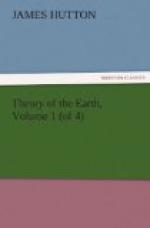Thus, in understanding the proper constitution of the present earth, we are led to know the source from whence had come all the materials which nature had employed in the construction of the world which appears; a world contrived in consummate wisdom for the growth and habitation of a great diversity of plants and animals; and a world peculiarly adapted to the purposes of man, who inhabits all its climates, who measures its extent, and determines its productions at his pleasure.
The whole of a great object or event fills us with wonder and astonishment, when all the particulars, in the succession of which the whole had been produced, may be considered without the least emotion. When, for example, we behold the pyramids of Egypt, our mind is agitated with a crowd of ideas that highly entertains the person who understands the subject; but the carrying a heavy stone up to the top of a hill or mountain would give that person little pleasure or concern. We wonder at the whole operation of the pyramid, but not at any one particular part.
The raising up of a continent of land from the bottom of the sea, is an idea that is too great to be conceived easily in all the parts of its operations, many of which are perhaps unknown to us; and, without being properly understood, so great an idea may appear like a thing that is imaginary. In like manner, the co-relative, or corresponding operation, the destruction of the land, is an idea that does not easily enter into the mind of man in its totality, although he is daily witness to part of the operation. We never see a river in a flood, but we must acknowledge the carrying away of part of our land, to be sunk at the bottom of the sea; we never see a storm upon the coast, but we are informed of a hostile attack of the sea upon our country; attacks which must, in time, wear away the bulwarks of our soil, and sap the foundations of our dwellings. Thus, great things are not understood without the analysing of many operations, and the combination of time with many events happening in succession.
Let us now consider what is to be the subject of examination, and where it is that we are to observe those operations which must determine either the stability or the instability of this land on which we live.
Our land has two extremities; the tops of the mountains, on the one hand, and the sea-shores, on the other: It is the intermediate space between these two, that forms the habitation of plants and animals. While there is a sea-shore and a higher ground there is that which is required in the system of the world: Take these away, and there would remain an aqueous globe, in which the world would perish. But, in the natural operations of the world, the land is perishing continually; and this is that which now we want to understand.




